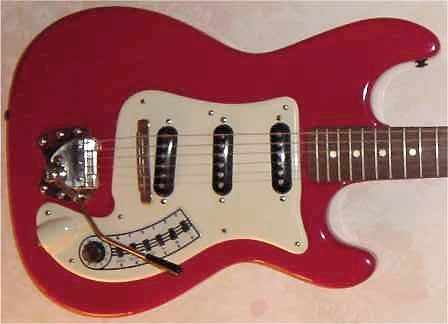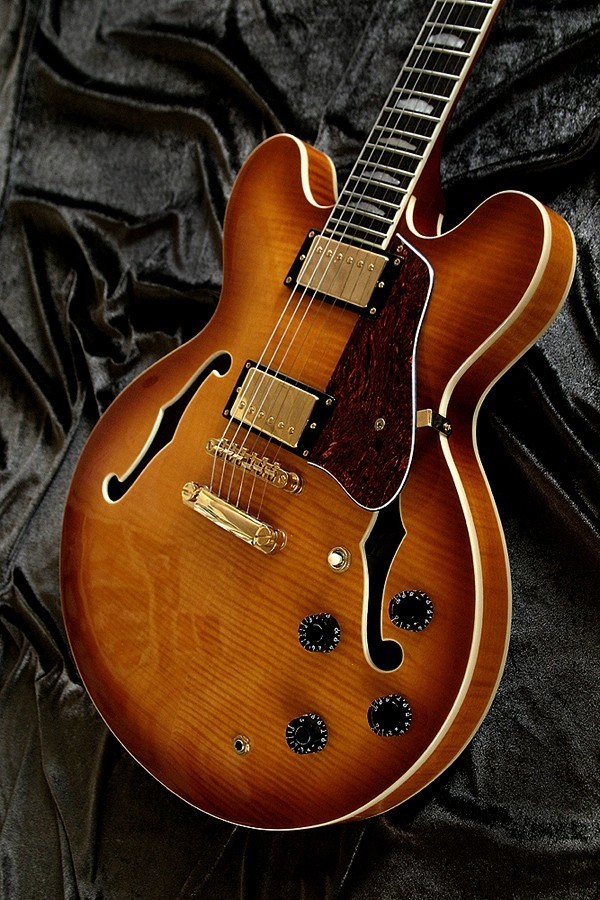1965 Hagström/Kent 'Bowie' model - my first electric guitar!
My very first electric guitar (I still have it) was a rather rare 1965 Hagström/Kent. This particular model was a version developed from the PB-24G (see below), but with an extra pickup (middle) . It was nicknamed 'the Bowie model' after David Bowie used one on his Aladdin Sane tour in 1973. It was also used in promo shots for his ‘Diamond Dogs’ album.
David Torn told me recently that this was his first electric guitar, too - and coincidentally, David later recorded with Bowie.
It was on this guitar that I learned to play. Countless hours trying to figure out those great solos by Carlos Santana, Eddie Van Halen, Terje Rypdal, Pete Haycock (Climax Blues Band), Ry Cooder, Mark Knopfler, John McLaughlin, Al DiMeola, Frank Marino, Tommy Bolin, and many more.
Me with my 'first love'...the Hagström, ca.1976
Hagström/Kent 'Bowie' model
Hagström PB-24G
1984 Ibanez Roadstar RS 1000
The RS1000 was my first 'proper' electric guitar. I enjoyed it a lot. Today these are ridicilously overpriced. They were OK guitars, but I guess those old Steve Lukather and Gary Moore advertisements drove the secondhand and 'vintage' prices in the air.
1987 Kramer Striker 300ST
The 80s - the age of big hair, spandex, and Floyd Rose-whammy bars. I was heavily into the music of Steve Vai and Joe Satriani, and I found the 'right' guitar in the Kramer Striker 300ST. The 300ST was the cheaper version of the Kramer Pacer Deluxe, with the HSS configuration on a pickguard with 5-way select and volume and tone (2 tones in my case) and the classic headstock.
Later on I also found that this guitar could do wonderful Hank B.Marvin-like tones through the bridge pickup! In 1993, I had the pleasure of meeting one of my guitar heroes, Phil Keaggy, who kindly signed my guitar. Someone in the audience jokingly shouted that I should sign Phil's one-of-a-kind (and very expensive) acoustic guitar made for Phil by luthier James Olsson. Phil politely declined by saying 'ehh... it's already signed...James Olsson signed it on the inside)....!
Phil Keaggy and I trying some three-handed guitar lines
1997 Fender Strat Plus
In 1997 I got my first Fender Stratocaster.
I opted for a brand new, gorgeous 'Strat Plus' model in Blue Burst finish, that I got through my friend John Tilden in Toronto. I still remember the heady, sweet, vanilla-like smell of fresh paint when I first opened the case!
These models have the 'noiseless' Fender Lace Sensor pickups, loved by some and hated by others. These pickups have a unique 'radiant Field Barrier system' that surrounds both the coil and magnets, reducing annoying 60-cycle hum. 'Lace Micro Combs' replace traditional bobbins, yielding a wider tonal range and better string balance than traditional guitar pickups, according to the manufacturer. I found them to work fine for my use back then, but compared to the Eric Johnson Strat that I'm using now, they probably would sound a bit lifeless and sterile.
A very comfy, good allrounder that I used as my main guitar until 2003.
2003 Music Man Silhouette
Another very versatile, good sounding workhorse that I enjoyed playing.
And this one probably had the best guitar neck I have ever played, by far.
As you can see in the photo, there's a Roland GK2A pickup attached to it - for use with my Roland VG88 or my Roland GR30 synth.
1985 IMG2010
Midi Controller Guitar
Around 1987, a local music dealer went out of business, and I got this 'beast' for almost nothing. I never really got to use it much (except recording some bad flute sounds to a 4-track cassette tape 'Portastudio'). It came with an MC-1 pitch-to-midi converter needed to be able to trigger sounds from a MIDI-equipped synthesizer. Abig, fat cable connected the controller to the converter.
It quickly became a 'dinosaur' and I traded it for two Korg synthesizers.
These are now quite rare. Around 2,000 were made. (Rumors say 500, but that's not correct).
The Ibanez IMG2010 was actually built at the same Fujigen factory (Japan) that made many of the best Japanese guitars of that era, including Roland synth controller guitars. Ibanez actually fixed some of the weaknesses that the Roland controllers had, and the IMG2010 adds a virtual whammy bar mentioned in the Roland service manuals but never implemented by Roland. The only reason I regret trading it away is that it had a great graphite-enforced neck.
Godin LGXT-SA
In my eternal search for versatile guitars, I bought a Godin LGXT-SA. The LGXT-SA is a 'three-voice' guitar featuring electric and acoustic guitar sounds, plus a 13-PIN output for synth access (S.A.). The output from the bridge transducer system in the LGX-SA produces six separate signals—one for each string. This divided signal is called hexaphonic and is used to drive guitar synths. As for using this guitar with the Roland VG-88's 'COSM' modelled guitars/amps, I noticed that the hexaphonic pickups were prone to create a slight 'rumble' when I picked the strings - which was never a problem using Roland's own GK2A attachable pickup (said to be a common issue with the VG88).
2007 Marlique custom hollowbody
Marlique custom hollowbody w/GraphTech 'GHOST' pickup (2006)
Built by luthier Toien Bernadhie, this Marlique hollowbody guitar had two humbuckers as well as a GraphTech GHOST piezo pickup and 13-pin output to control my Roland VG88 or GR30. A truly wonderful guitar.
Toien Bernadhie also built me this gorgeous hollowbody, which is now one of my main guitars. It has a truly wonderful, full, fat tone.
Funny coincidence: Back in 2007, the late, great guitar player Pete Haycock (Climax Blues Band, ELO, Hans Zimmer), told me that my playing and tone reminded him of Jan Akkerman (Pete produced Jan Akkerman's 'The Noise of Art' album). 11 years forward: A few weeks ago I discovered that Jan recently has started playing guitars made by Toien Bernadhie, as well! Maybe Pete gave him a tip?
2006 Fender Eric Johnson Signature Stratocaster
Probably the guitar I use the most. I guess that when Eric Johnson lets Fender use his signature on one of their guitars, that guitar is as good as it gets! And although I had to matten the neck down a bit since the nitrocellulose lacquer felt waaaay too sticky for my taste, I am exremely satisfied with this exceptional Stratocaster. Judging from its serial number, mine is one of the earlier ones. I know that they've made cosmetic changes to this model in recent years, but I certainly can't think of anything I'd like to see changed on mine.
The EJ Strat has three specially designed single-coil pickups with countersunk mounting screws, as well as a 1957-style, two-piece alder body with deeper contours and cavities than your more standard and modern strats. It also has a one-piece quartersawn maple neck with a soft V-shaped profile, and a maple neck with a 25.5" scale length and a 1.65" nut width.
And it has a HEAVENLY tone.
....and some other guitars:
A beautiful guitar from the Polish guitar maker Mayones. I don't recall the model name.
Gibson ES335-style guitar from DB Guitars, Denmark.
Suzuki Strat copy
Ibanez Artcore AS73 hollowbody
Marlique solidbody
...and another Marlique solidbody
DB Guitars Mahogany Rock
A Telecaster made from miscellaneous parts. Still used on an regular basis.































